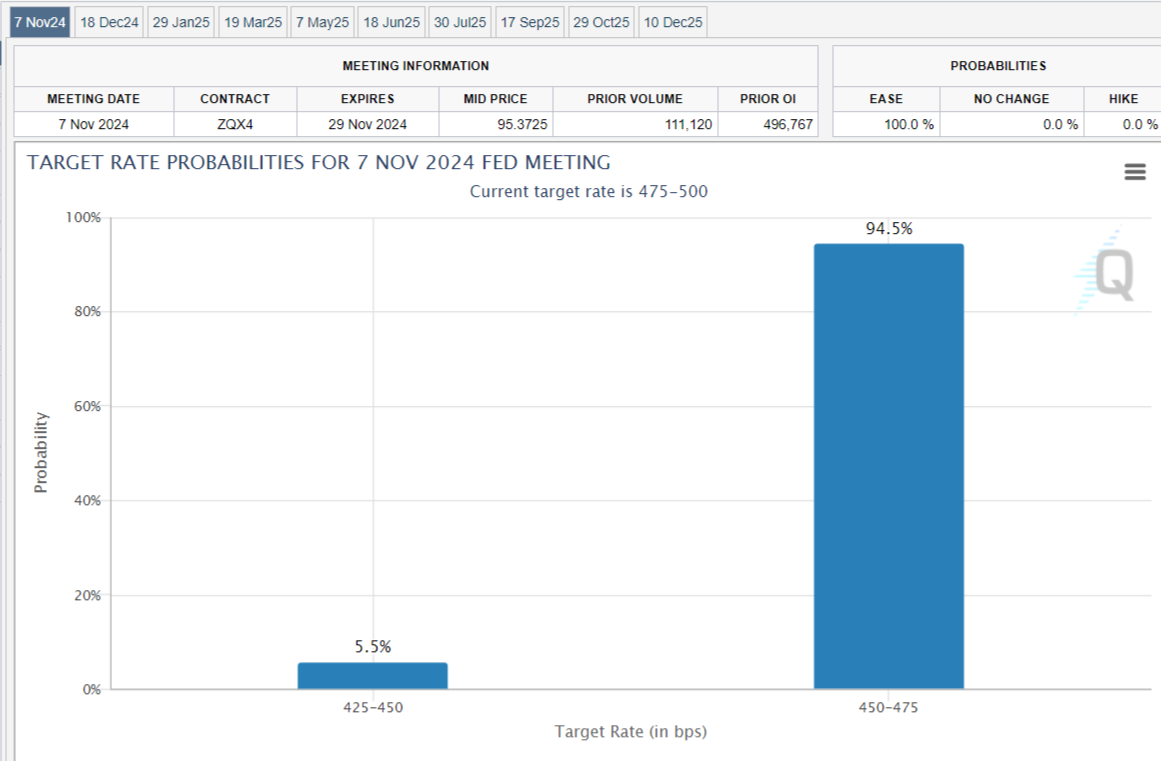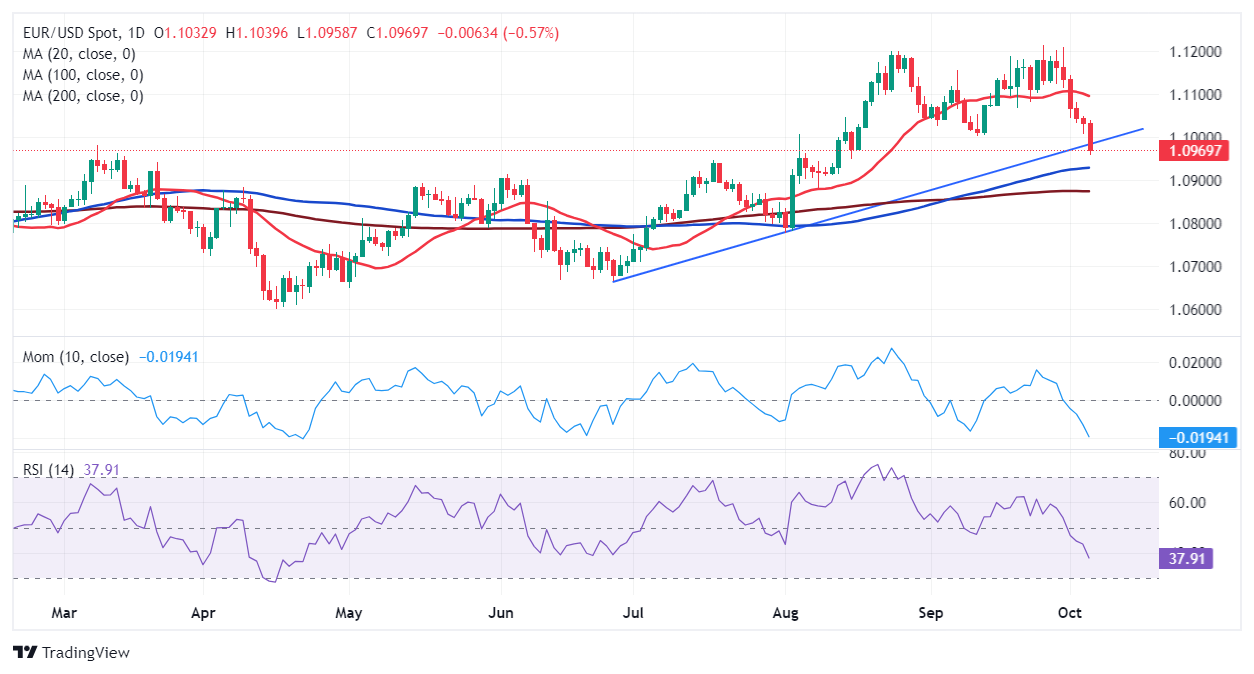- The United States Nonfarm Payrolls report largely surpassed market expectations in September.
- European data keeps highlighting the economy’s fragility and persistent recessionary risks.
- EUR/USD broke below the 1.1000 mark, and could extend its slump in the upcoming days.
The EUR/USD pair kick-started October with a weak note, plummeting to 1.0958 on Friday following an upbeat surprise from United States (US) employment figures. As a result, the US Dollar (USD) advanced amid decreasing bets on another Federal Reserve (Fed) aggressive interest rate cut after encouraging US macroeconomic data. Additionally, the Greenback found support in an escalating Middle-East conflict that pushed speculative interest into safety.
Back-and-forth air strikes between Israel and its Islamic neighbours took centre stage this week and spurred fears the situation will continue to escalate. Concerns about oil supply interruptions dominated the headlines and pushed the price of black gold sharply up. As a result, stock markets struggled for momentum, with US equity indexes heading into the weekly close with a mixed tone.
US employment figures brought relief
The US released multiple employment-related data ahead of September’s Nonfarm Payrolls (NFP) report published on Friday, which showed the labor market is gaining momentum.
The ADP report on private job creation showed the sector added 143K new jobs in September, better than the 120K anticipated. Additionally, the number of job openings on the last business day of August stood at 8.04 million, as reported in the Job Openings and Labor Turnover Survey (JOLTS).
The September Challenger Job Cuts showed that US-based employers announced 72,821 cuts in the month, a 4% decrease from the 75,891 cuts announced one month prior, while Initial Jobless Claims for the week ended September 27 rose by 225K, worse than the 220K anticipated.
Finally on Friday, the NFP report showed the US added 254K new jobs in September, while the Unemployment Rate fell to 4.1%. The US Dollar skyrocketed with the news, retaining its strength ahead of the weekly close.
Other than that, the US published the ISM Services Purchasing Managers’ Index (PMI), which unexpectedly improved to 54.9 in September from 51.5 in August. The ISM Manufacturing PMI for the same month, however, resulted at 47.2, missing expectations of 47.5.
At the end of the week, the odds for a 50 bps rate cut from the Fed plummeted to 5.5%, although the other 94.5% foresees a 25 bps trim.

What’s going on in Europe
The European macroeconomic calendar included inflation and growth-related updates. Germany reported that the September Harmonized Index of Consumer Prices (HICP) declined 0.1%, according to preliminary estimates, while the annual HICP rose 1.8%, below the previous 2%. The broadly Eurozone’s (EU) HICP also rose 1.8% in the year to September, declining from the 2.2% posted in August.
On a down note, the final Hamburg Commercial Bank (HBOC) Purchasing Managers Index (PMI) showed upward revisions to manufacturing and services output. The final EU Composite PMI was confirmed at 49.6, better than the previous 48.9. Also, the EU Producer Price Index (PPI) increased by 0.6% on a monthly basis in August, according to first estimates from Eurostat. The annual PPI printed -2.3%, also better than expected.
Easing inflationary pressures combined with tepid PMIs’ progress brought modest relief, not enough to take the Euro out of its bearish path.
Finally, the European Central Bank (ECB) President Christine Lagarde hit the wires at the beginning of the week but provided no fresh insights on monetary policy. Lagarde repeated that the ECB would keep policy rates “sufficiently restrictive for as long as necessary,” adding that the latest developments strengthened policymakers’ confidence that inflation would return to target in a timely manner.
Next in the macroeconomic docket
The upcoming week will feature a couple of critical macroeconomic reports. The US will publish the Federal Open Market Committee (FOMC) meeting Minutes on Wednesday and the September Consumer Price Index (CPI), previously at 2.5% YoY on Thursday. The country will also publish September PPI data and the preliminary estimate of the October Michigan Consumer Sentiment Index on Friday. Across the pond, the calendar will be a tad lighter as the EU will unveil August Retail Sales on Monday and the ECB Monetary Policy Meeting Accounts on Thursday.
Central banks’ statements are not actually expected to shed much light on future monetary policy decisions, as officials at both shores of the Atlantic have reaffirmed that their decisions will be data-dependent and that those decisions will be made meeting-by-meeting. On the contrary, recent data has set policymakers’ course of action.

EUR/USD technical outlook
The weekly chart for the EUR/USD pair shows it trades at levels last seen in mid-August. Even further, the pair broke below an ascendant trend line coming from 1.0665, the June 26 daily low, currently at around 1.0980. The chart shows the pair has broken below a mildly bearish 200 Simple Moving Average (SMA), and nears the 20 SMA, which losses upward strength and provides support in the 1.0930 area. Technical indicators, in the meantime, have turned firmly lower but so far hold above their midlines.
The EUR/USD pair daily chart shows it fell for six consecutive days, maintaining a strong downward momentum. Technical indicators aim lower almost vertically and are approaching oversold readings without any sign of bearish exhaustion. At the same time, the 20 SMA gains downward traction at around 1.1095, while the 100 and 200 SMA have turned flat below the current level, reflecting the lack of buying interest seen in these last few days.
Approaches to the 1.1000 mark should attract sellers to keep the bearish momentum alive, with the following support in the 1.0930 area en route to 1.0860. A steady recovery above the 1.1000 threshold could see the pair recovering towards 1.1070, where it has multiple intraday lows between August and September. Beyond the latter, a run towards 1.1140 should come next, albeit the US Dollar’s weakness seems unlikely at the time being.




